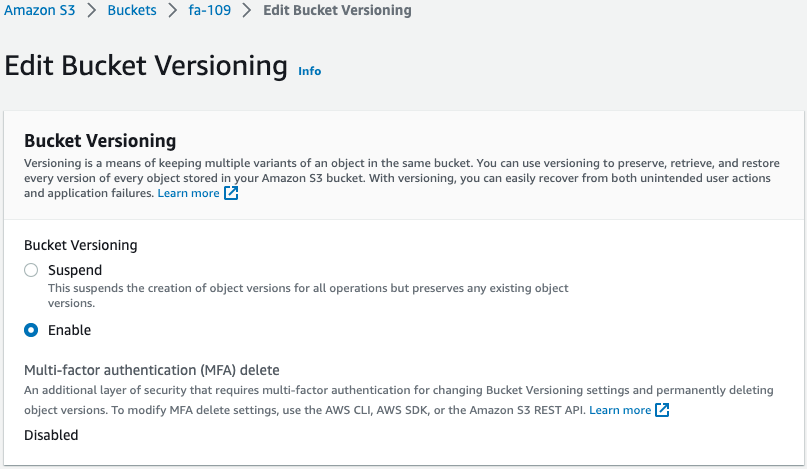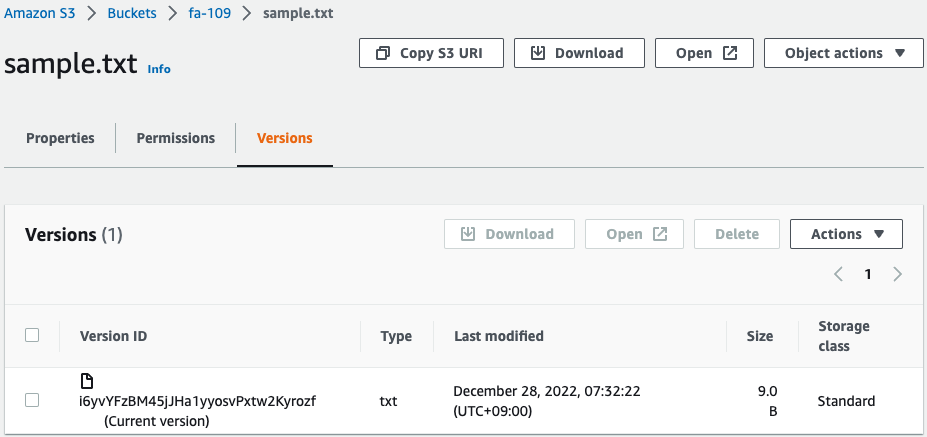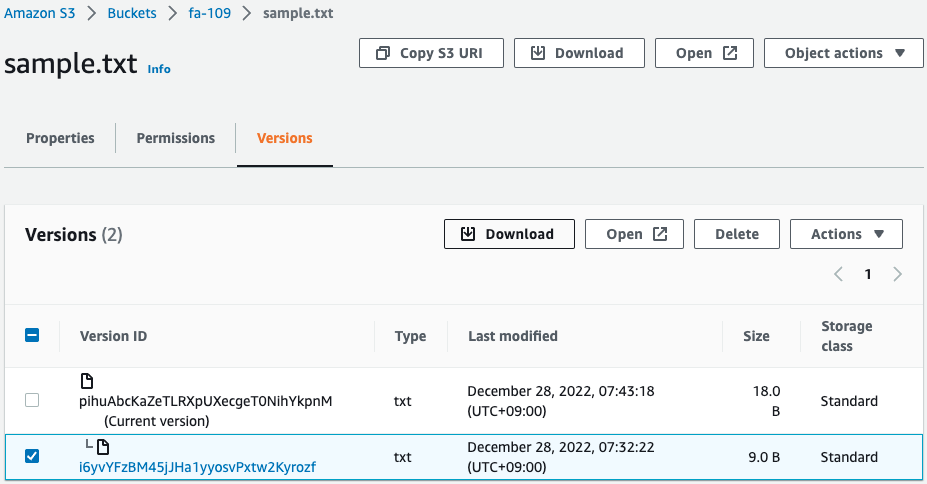Use CloudFormation to create S3 buckets with versioning enabled
One of the features S3 offers is versioning.
Versioning in Amazon S3 is a means of keeping multiple variants of an object in the same bucket. You can use the S3 Versioning feature to preserve, retrieve, and restore every version of every object stored in your buckets.
Using versioning in S3 buckets
In this case, we will use CloudFormation to create an S3 bucket with versioning enabled.
Environment

Create an S3 bucket.
Enable versioning for the bucket.
CloudFormation template files
Build the above configuration with CloudFormation.
The CloudFormation templates are located at the following URL
https://github.com/awstut-an-r/awstut-fa/tree/main/109
Explanation of key points of the template files
S3 bucket
Resources:
Bucket:
Type: AWS::S3::Bucket
Properties:
AccessControl: Private
BucketName: !Ref Prefix
VersioningConfiguration:
Status: Enabled
Code language: YAML (yaml)Versioning is set by the VersioningConfiguration property.
Versioning is enabled by setting the internal Status property to “Enabled”.
Architecting
Use CloudFormation to build this environment and check the actual behavior.
Create CloudFormation stacks and check resources in stacks
Create a CloudFormation stacks.
For information on how to create stacks and check each stack, please refer to the following page

After checking the resources in each stack, information on the main resources created this time is as follows
- S3 bucket: fa-109
Check each resource from the AWS Management Console.
Check the S3 bucket.

It is indeed versioning is enabled.
Checking Action
Object Preserve
Now that everything is ready, place objects in this bucket.
Using the AWS CLI, place a test file
$ echo 'hogehoge' > sample.txt
$ aws s3 cp sample.txt s3://fa-109/
upload: ./sample.txt to s3://fa-109/sample.txt
Code language: Bash (bash)Check the status of the S3 bucket.

The test file is indeed placed in the bucket.
Check the versioning information of this object.

Versioning information is displayed.
Since the object has just been placed in the bucket, the current status is the latest version.
Object Update
Next, we check the behavior of the object when it is updated.
Update the object again from AWS CLI.
$ echo 'fugafuga' >> sample.txt
$ aws s3 cp sample.txt s3://fa-109/
upload: ./sample.txt to s3://fa-109/sample.txt
Code language: Bash (bash)Check the status of the S3 bucket again.

The version has been updated because the object has been updated.
As you can see, not only the latest version, but also older versions of the object can be downloaded.
You can download from the management console like this, but you can also download older versions of objects from the AWS CLI.
The procedure is as follows
- Confirm the version ID from the object’s version list
- Obtain the object by specifying the version ID
Let’s actually do this.
First, check the version list of the object.
$ aws s3api list-object-versions \
--bucket fa-109 \
--prefix sample.txt
{
"Versions": [
{
"ETag": "\"304693ccbc28bbeac4689b24bda76e0e\"",
"Size": 18,
"StorageClass": "STANDARD",
"Key": "sample.txt",
"VersionId": "pihuAbcKaZeTLRXpUXecgeT0NihYkpnM",
"IsLatest": true,
"LastModified": "2022-12-27T22:43:18+00:00",
"Owner": {
"DisplayName": "[owner-name]",
"ID": "[owner-id]"
}
},
{
"ETag": "\"d9a3fdfc7ca17c47ed007bed5d2eb873\"",
"Size": 9,
"StorageClass": "STANDARD",
"Key": "sample.txt",
"VersionId": "i6yvYFzBM45jJHa1yyosvPxtw2Kyrozf",
"IsLatest": false,
"LastModified": "2022-12-27T22:32:22+00:00",
"Owner": {
"DisplayName": "[owner-name]",
"ID": "[owner-id]"
}
}
]
}
Code language: Bash (bash)The first is the latest version.
This can be determined from the IsLatest value.
The second is the older version.
The value of VersionId is “pihuAbcKaZeTLRXpUXecgeT0NihYkpnM,” which is the version ID of the older version.
Now that we know the version ID, we can retrieve the old version object.
$ aws s3api get-object \
--bucket fa-109 \
--key sample.txt \
--version-id i6yvYFzBM45jJHa1yyosvPxtw2Kyrozf \
sample_old.txt
{
"AcceptRanges": "bytes",
"LastModified": "2022-12-27T22:32:22+00:00",
"ContentLength": 9,
"ETag": "\"d9a3fdfc7ca17c47ed007bed5d2eb873\"",
"VersionId": "i6yvYFzBM45jJHa1yyosvPxtw2Kyrozf",
"ContentType": "text/plain",
"Metadata": {}
}
$ cat sample_old.txt
hogehoge
Code language: Bash (bash)The object has been downloaded.
The content is indeed the one before the update.
Summary
We have seen how to use CloudFormation to create an S3 bucket with versioning enabled and how to retrieve an old version of an object.